 conference
conference
River Flow 2020
The 10th International Conference in Fluvial Hydraulics, organized by TU Delft, IHE Delft Institute for Water Education, Deltares and Rijkswaterstaat (Ministry of Infrastructure and Water Management, the Netherlands), together with the International Association for Hydro- Environment Engineering and Research (IAHR) and the Netherlands Centre for River Studies (NCR), has been held from the 7th to the 10th of July.
Researchers from water-related disciplines like Hydraulics, Morphodynamics, Ecology and Integral approaches presented their work digitally, and the contents were exceptionally available for the attendees to discuss upon until the 17th of July due to the COVID-19 (SARS-CoV-2) pandemic. Among the varied topics in fluid mechanics, river monitoring, extreme events and rivers under pressure, few studies focused on optimized numerical modelling techniques, as well as visualization and flood risk communication.




Flood risk communication using digital twins (Heyer et al., 2020)
Adina presented the “Current trends in the optimization of hydraulic flood simulations in ungauged steep rivers” in the session “Numerical Modelling – Applications”. Her presentation (available here) summarized few optimization techniques nowadays applied to the the hydraulic analysis of floods and addressed their advantages and limitations when applied to steep rivers where historical hydrologic data is seldom available.
Alongside with the different thematic sessions arranged, young researchers were given the opportunity to present and discuss varied topics in masterclasses arranged by experienced researchers. For instance, Adina participated on the 6th of July in the masterclass “The Digital River”, organized by Enrica Viparelli (University of South Carolina) and Ioana Popescu (IHE Delft).

The conference program had other highlights, such as an e-social gathering and keynote lectures in “Future generations fighting climate change” (Gabriela Eslava Bejarano, Columbia University, USA), “Rivers Dynamics in Regions of Rapid Climate Change” (Irina Overeem, University of Colorado at Boulder, USA) and “When a tree falls in a river… a cascade process begins” (Virginia Ruiz-Villanueva, University of Lausanne, Switzerland).






































